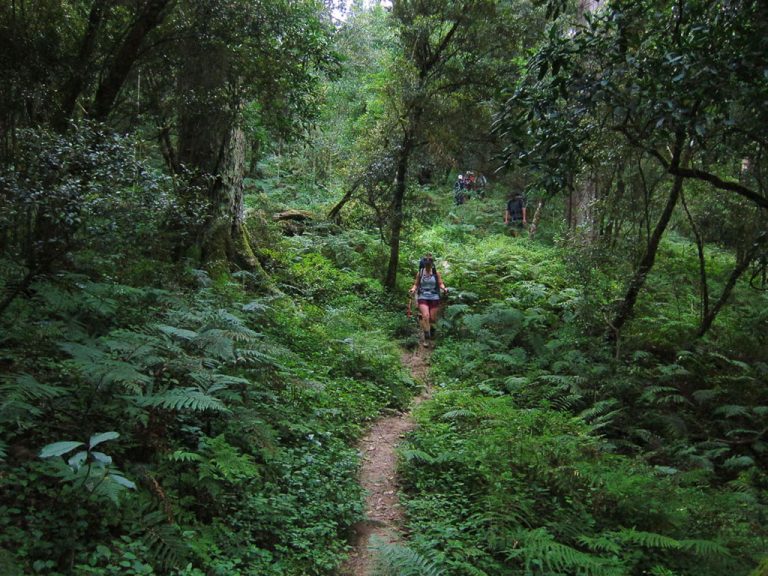A recent study from North America suggests that lost day hikers are more vulnerable when it comes to getting stranded and facing the elements.
It may seem a bit obvious, but the reality is that day hikers are less prepared for spending extended, unplanned time in a forest or mountainous environment without enough food, water or the right equipment necessary for cooking, sleeping and protecting oneself.

Amatola Trail, Eastern Cape.
The study from a Smoky Mountains online tourism resource suggests that apart from injury or inclement weather, those who veer off the trail are the most vulnerable, being the least likely to survive indefinitely before they find their way back or are found.
In South Africa, the hiking environments you might be more likely to flounder in are probably the Knysna Forest, Tsitsikamma, Amatola and Drakensberg for their sheer expanse, and the type of vegetation in these areas – dense and easy to get lost in. These areas are also remote in parts and with many paths. There aren’t always visible landmarks to navigate with, and if injury strikes, mobility may be limited and the risk of hypothermia becomes even greater.
An extreme example from abroad is the Taiwanese ‘bikini climber’ who infamously fell and froze to death shortly after her obligatory outfit change into a bikini upon summiting. An extreme example, but one that demonstrates the importance of body temperature in the grand scheme of survival.
Often the hiking stories that make the news in South African revolve around deaths and search-and-rescue operations that are injury-induced, like hikers falling and injuring themselves, often fatally.

Andreas Groenewald pointing out where the hike will end on day one of the Green Mountain Trail. Image: Teagan Cunniffe.
Everyone wants to pack light, but unpreparedness can be fatal when you’re lost without any tools or protective gear. Staying warm really is essential, but is perhaps overlooked in lieu of concerns over food and water. Having suitable clothes (not just a T-shirt and three-quarter tights or shorts) is often an oversight for day hikers, who likely aren’t prepared for when the sun sets and temperatures plummet. Lodgings are important as well, but difficult to plan for when packing for a day trip. This is where warm layers are especially important and can make the difference between survival and death by injury and/or hypothermia.
Regardless of stats in the US and different terrain, vegetation and size of hiking environments, the tips and stats point to some useful guidelines for responsible trekking wherever you are. The forests you’re likely to get lost in are going to be the bigger ones, with many trails which can become confusing and disorienting. The study comprises scouring through about 25 years and over 100 reports of missing persons and accounts of how they stayed alive. Wandering off the trail accounts for 41 per cent of most search-and-rescue missions in the US study, with injury and bad weather following close behind. South Africans and tourists hiking in similarly vast, wild areas should take the necessary precautions.
In the Smoky Mountains study, the majority of lost wanderers kept trying to find their way back (65%) rather than staying where they were; however, most were rescued as opposed to finding their way back on their own. They also managed to survive by staying warm because of their clothing, fires and camping gear, and surprisingly with very little food (if they had any on them it was rationed, but most had nothing).

Luminous leucadendrons adorn the flanks of Sleeping Beauty peak, on the far eastern edge of the Langeberg. Image: Chris Davies.
Basic tips
– Pack a lightweight padded jacket and/or space blanket
– A raincoat is very practical, for keeping dry (and warm later) and for makeshift shelters
– Let at least one person know where you’ll be, when you plan to return, and an outline of the route/hike
– Study the route beforehand, and get your bearings in case you go off-trail and need to navigate back or avoid potentially dangerous areas. Print a map of the area.
– Bring a small first aid kit with basic/useful supplies, solutions
– Matches and/or lighters in a waterproofed environment, i.e. taped closed or in Ziploc-type packaging
Images: supplied
You may also like
Related Posts
Whether you’re in a two-person hiking tent eye-balling the peaks or a full caravan in...
read more
Gabrielle Jacobs forsakes the Breede Valley’s winelands for some Cape nature at Vrolijkheid Nature Reserve,15km...
read more
A new guided hike in the Western Cape known as the 16 Mile Beach Challenge...
read more